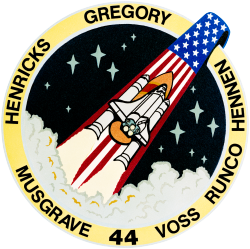STS-48
| STS-48 | |||||
 | |||||
| Uppdrag | 43 | ||||
|---|---|---|---|---|---|
| Rymdfärja | Discovery (13)[1] | ||||
| NSSDC-ID | 1991-063A[2] | ||||
| Färdens tid | 5 dagar, 8 timmar, 27 minuter, 38 sekunder | ||||
| Uppskjutning | |||||
| Startplats | Startplatta 39A vid Kennedy Space Center i Florida | ||||
| Start | 12 september 1991, 7:11:04 p.m. EDT | ||||
| Landning | |||||
| Landningsplats | Runway 22 Edwards AFB, California | ||||
| Landning | 18 september 1991, 12:38:42 a.m. PDT | ||||
| Omloppsbana | |||||
| Varv | 81 st[3] | ||||
| Apogeum | 580 km | ||||
| Perigeum | 575 km | ||||
| Banlutning | 57,0° | ||||
| Sträcka | 3,530 miljoner km | ||||
| Besättning | |||||
| Befälhavare | John O. Creighton (3) | ||||
| Pilot | Kenneth S. Reightler (1) | ||||
| Uppdragsspecialister | James F. Buchli (4) Charles D. Gemar (2) Mark N. Brown (2) | ||||
 | |||||
| Kronologi Rymdfärjeprogrammet | |||||
| |||||
STS-48 var den fyrtiotredje flygningen i det amerikanska rymdfärjeprogrammet och den trettonde flygningen med rymdfärjan Discovery. Den sköts upp från Pad 39A vid Kennedy Space Center i Florida den 12 september 1991. Efter drygt fem dagar i omloppsbana runt jorden återinträdde rymdfärjan i jordens atmosfär och landade vid Edwards Air Force Base i Kalifornien.
Flygningens huvudsyfte var att placera satelliten Upper Atmosphere Research Satellite (UARS) i omloppsbana runt Jorden.
Se även
Referenser
- ^ NASA Space Shuttle Launch Archive Arkiverad 28 juli 2012 hämtat från the Wayback Machine., läst 28 juli 2016.
- ^ ”NASA Space Science Data Coordinated Archive” (på engelska). NASA. https://nssdc.gsfc.nasa.gov/nmc/spacecraft/display.action?id=1991-063A. Läst 19 mars 2020.
- ^ Manned Astronautics - Figures & Facts Arkiverad 1 april 2016 hämtat från the Wayback Machine., läst 28 juli 2016.
Externa länkar
 Wikimedia Commons har media som rör STS-48.
Wikimedia Commons har media som rör STS-48.
| ||||||||
| ||||||||||||||||||||||||||||||||
Media som används på denna webbplats
Författare/Upphovsman: Pascal (Flickr user: pasukaru76), Licens: CC0
Vostok spacecraft replica at the Technik Museum Speyer, Germany.
The STS-48 crew portrait includes (front row left to right): Mark N. Brown, mission specialist; John O. Creighton, commander; and Kenneth S. Reightler, pilot. Pictured on the back row (left to right) are mission specialists Charles D. (Sam) Gemar, and James F. Buchli. The crew of five launched aboard the Space Shuttle Discovery on September 12, 1991 at 7:11:04 pm (EDT). The primary payload of the mission was the Upper Atmosphere Research Satellite (UARS).
STS-43 Mission Insignia
- Designed by the astronauts assigned to fly on the mission, the STS 43 patch portrays the evolution and continuity of the USA's space program by highlighting 30 years of American manned space flight experience -- from Mercury to the Space Shuttle. The emergence of the Shuttle Atlantis from the outlined configuration of the Mercury space capsule commemorates this special relationship. The energy and momentum of launch are conveyed by the gradations of blue which mark the Shuttle's ascent from Earth to space. Once in Earth orbit, Atlantis' cargo bay opens to reveal the Tracking and Data Relay Satellite (TDRS) which appears in gold emphasis against the white wings of Atlantis and the stark blackness of space. A primary mission objective, the Tracking and Data Relay Satellite System (TDRSS) will enable almost continuous communication from Earth to space for future Space Shuttle missions. The stars on the patch are arranged to suggest this mission's numerical designation, with four stars left of Atlantis and three to the right.
STS-44 Mission Insignia
STS-48 Mission Insignia
- Designed by the astronaut crewmembers, the STS 48 patch represents the Space Shuttle Orbiter Discovery in orbit about the Earth after deploying the Upper Atmospheric Research Satellite (UARS) depicted in block letter style. The stars are those in the Northern Hemisphere as seen in the fall and winter when UARS will begin its study of Earth's atmosphere. The color bands on Earth's horizon, extending up to the UARS spacecraft, depict the study of Earth's atmosphere. The triangular shape represents the relationship among the three atmospheric processes that determine upper atmospheric structure and behavior: chemistry, dynamics and energy. In the words of the crewmembers, This continuous process brings life to our planet and makes our planet unique in the solar system."








